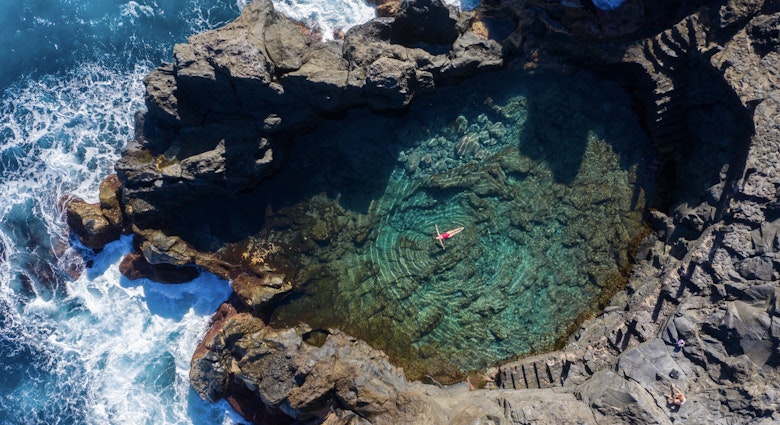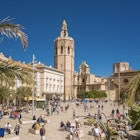
Nov 19, 2024 • 4 min read
Sponsored by
{
"url": "preserving-spains-heritage",
"destination": "Spain",
"continent": "Europe",
"country": "Spain"
}
Jul 16, 2024 • 5 min read

Spain is a global leader in cultural preservation. Experience some of the most rewarding fruits of that labor in Madrid and Barcelona.
The passionate rhythms of flamenco, respected galleries both cutting-edge and classic, lively cities that burst with architectural masterworks spanning the centuries – Spain’s immense cultural riches have grown into just as much a draw as its dazzling costas. Today, this rich artistic heritage is making the country a leading, forward-thinking force in cultural preservation, which travelers can savor anywhere from Andalucía’s evocative pueblos blancos (white villages) and the remote hamlets of the wild Pyrenees to some of Europe’s top arts hubs in cities like Madrid, Barcelona, Bilbao and Málaga.
For some of Spain’s most rewarding cultural experiences, start at the two urban powerhouses of Madrid and Barcelona. These cities are home to some of the globe’s finest galleries, an array of entrancing Spanish performance arts and an unmissable lineup of UNESCO-listed monuments begging to be explored.











Park Güell is known for its unique architectural elements, colorful mosaic-covered structures, and organic shapes that reflect architect Antoni Gaudí's distinctive style. Matt Paco for Lonely Planet
Catalonia’s Mediterranean-side capital Barcelona is defined by the whimsical Modernisme movement, which swept through the city’s newly created district of L’Eixample in the late 19th and early 20th centuries. Some of Spain’s most respected architects on record designed a wave of otherworldly, nature-inspired mansions and other buildings for wealthy Catalan families here. Among them was the great Antoni Gaudí, whose seven major Modernista works now make up a joint UNESCO World Heritage Site.
It can be tricky to know where to start with Gaudí, but headliners like leafy Park Güell, wave-like La Pedrera and tile-covered Casa Batlló are highlights of any Spain visit. Many of Barcelona’s Gaudí monuments have also been busy working on creative new initiatives tapping into contemporary art and design, including Casa Batlló, where an edgy prize-winning renovation has brought in sensory experiences, modern-art installations and rooftop concerts. Our top tips for exploring Gaudí’s Barcelona? Be sure to see the buildings’ interiors (not just the outside) and, if possible, join a tour with a local architect to discover their many extra layers, such as those offered by Barcelona Architecture Walks.
But Barcelona has countless other Modernisme jewels beyond Gaudí, including the showstopping creations of his contemporary Lluís Domènech i Montaner. Arguably most spectacular is the Palau de la Música Catalana in La Ribera district; this still-in-use 1908 concert hall stops people in their tracks with its floral-adorned exterior and vibrant trencadís (smashed-up tilework). Since 1997, it has been a joint UNESCO-listed monument along with another of Domènech i Montaner’s great works, the Recinte Modernista de Sant Pau, an astonishingly colorful former hospital just a few blocks away from Gaudí’s La Sagrada Família.


Madrid, meanwhile, now has its own UNESCO-worthy architectural masterpiece in the 16th-century tree-lined Paseo del Prado (among the world’s great art hubs and also a pioneer in opening up art to the wider public) and the Parque del Buen Retiro, whose sprawling 118 landscaped hectares date from the 17th century. Both were granted joint World Heritage status in 2021. Go running, walking or cycling around El Retiro on any Madrid morning, and you’ll be surrounded by madrileños (locals) out enjoying one of Spain’s most-loved green havens. Just outside the Spanish capital, meanwhile, you can stroll through the magnificent UNESCO-listed San Lorenzo de El Escorial monastery and palace complex, built in the 16th century for Felipe II.


With enough landmark galleries and ancient masterpieces to rival the globe’s finest art cities, there’s no better place to step into the immense riches of Spain’s art world than soulful Madrid, where the Golden Triangle of Arts is deservedly top of everyone’s list. Start by seeking out the Spanish Masters at the fabulous Museo del Prado, which ranks among the world’s top art galleries (beat some of the crowds by arriving first thing). Part of the Paseo del Prado UNESCO World Heritage Site, the Prado holds such icons as Velázquez’s Las Meninas and Goya’s Black Paintings and was originally conceived as a science museum back in the late 18th century.
More Spanish art marvels await at the nearby Centro de Arte Reina Sofía, where Picasso’s harrowing Guernica steals the show, while the dynamic Museo Thyssen-Bornemisza completes Madrid’s art triangle with its impressive collection of European art throughout the centuries. Or, for something more offbeat, visit the quiet former Madrid home of the renowned Valencia artist Joaquín Sorolla, whose groundbreaking use of light deserves its own chapter in Spain’s art story.


Barcelona has a wave of big-hitter galleries, too, where the legacy of such Spanish greats as Joan Miró and Antoni Tàpies, as well as Picasso, can be admired in cutting-edge spaces designed to enhance the art itself. Both cities are now home to energetic street-art scenes, best enjoyed on an independent stroll or an expert-guided tour around El Raval in Barcelona or Lavapiés in Madrid.


Few moments capture the essence of Spain quite like catching a feisty flamenco performance in all its foot-stomping, skirt-swishing, guitar-strumming beauty. With its roots in Andalucía’s Roma communities, this passion-driven art fusing dance, music and song was named an Intangible Cultural Heritage of Humanity by UNESCO in 2010, and both Madrid and Barcelona are known for their lively modern-day flamenco scenes. In many ways, tourism can help preserve ancient arts like flamenco, which is traditionally passed down through families, peñas (clubs) and other associations around Spain.
To find an authentically good flamenco show, it pays to research ahead and seek out local experts. Madrid’s Tablao Flamenco 1911 and Corral de la Morería are both respected, long-running venues, or time a visit to Barcelona to coincide with the well-regarded Ciutat Flamenco autumn festival, going strong for three decades.


As of 2024, Spain has the fifth-highest number of UNESCO-recognized assets in the world, with a whopping 50 sites inscribed on the World Heritage List – beaten only (and narrowly) by Italy, China, France and Germany.
The latest addition are the curious prehistoric Talayotic monuments of go-slow Menorca, which won UNESCO recognition in 2023. Other standouts take in the Renaissance monuments of Úbeda and Baeza in northern Andalucía, the glittering old town of Galicia’s storied capital Santiago de Compostela and the various Caminos de Santiago walked by more than 400,000 pilgrims each year.
Then there’s a crop of Spanish cultural elements recognized by UNESCO’s Intangible Cultural Heritage of Humanity List, such as Catalonia’s famous castells (human towers), Valencia’s Fallas festivities and even the Mediterranean diet.
In short, examples of Spain’s preserved culture can be found throughout the country. For the perfect next step to explore Spain’s preserved cultural treasures beyond Barcelona and Madrid, head for any one of its 15 World Heritage Cities. From the architectural wonders of Cuenca and Toledo, to the Roman ruins of Segovia and Terregona, there’s an incomparable sight around every corner.
As a travel entertainment and inspirational media outlet, we sometimes incorporate brand sponsors into our efforts. This activity is clearly labeled across our platforms.
This story was crafted collaboratively between Turespaña and Lonely Planet. Both parties provided research and curated content to produce this story. We disclose when information isn’t ours.
With sponsored content, both Lonely Planet and our brand partners have specific responsibilities:
Determines the concept, provides briefing, research material, and may provide feedback.
We provide expertise, firsthand insights, and verify with third-party sources when needed.
{
"url": "preserving-spains-heritage",
"destination": "Spain",
"continent": "Europe",
"country": "Spain"
}

Nov 19, 2024 • 4 min read


Nov 6, 2024 • 7 min read

Nov 6, 2024 • 9 min read


Oct 23, 2024 • 6 min read


